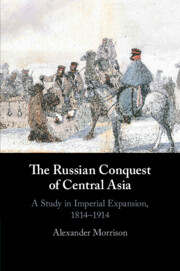Book contents
- The Russian Conquest of Central Asia
- The Russian Conquest of Central Asia
- Copyright page
- Dedication
- Contents
- Illustrations
- Maps
- Tables
- Acknowledgements
- Note on Translation, Transliteration and Dates
- Abbreviations
- Glossary
- Maps
- Introduction
- 1 Russia’s Steppe Frontier and the Napoleonic Generation
- 2 ‘Pray for the Camels’: The Winter Invasion of Khiva, 1839–41
- 3 ‘This Particularly Painful Place’: The Failure of the Syr-Darya Line as a Frontier, 1841–63
- 4 From Ayaguz to Almaty: The Conquest and Settlement of Semirechie, 1843–82
- 5 The Search for a ‘Natural’ Frontier and the Fall of Tashkent, 1863–5
- 6 War with Bukhara, 1866–8
- 7 The Fall of Khiva, 1872–3
- 8 ‘Those Who Should Be Spared’: The Conquest of Ferghana, 1875–6
- 9 ‘The Harder You Hit Them, the Longer They Will Be Quiet Afterwards’: The Conquest of Transcaspia, 1869–85
- 10 Aryanism on the Final Frontier of the Russian Empire: The Exploration and Annexation of the Pamirs, 1881–1905
- Epilogue: After the Conquest
- Sources and Bibliography
- Index
6 - War with Bukhara, 1866–8
Published online by Cambridge University Press: 19 November 2020
- The Russian Conquest of Central Asia
- The Russian Conquest of Central Asia
- Copyright page
- Dedication
- Contents
- Illustrations
- Maps
- Tables
- Acknowledgements
- Note on Translation, Transliteration and Dates
- Abbreviations
- Glossary
- Maps
- Introduction
- 1 Russia’s Steppe Frontier and the Napoleonic Generation
- 2 ‘Pray for the Camels’: The Winter Invasion of Khiva, 1839–41
- 3 ‘This Particularly Painful Place’: The Failure of the Syr-Darya Line as a Frontier, 1841–63
- 4 From Ayaguz to Almaty: The Conquest and Settlement of Semirechie, 1843–82
- 5 The Search for a ‘Natural’ Frontier and the Fall of Tashkent, 1863–5
- 6 War with Bukhara, 1866–8
- 7 The Fall of Khiva, 1872–3
- 8 ‘Those Who Should Be Spared’: The Conquest of Ferghana, 1875–6
- 9 ‘The Harder You Hit Them, the Longer They Will Be Quiet Afterwards’: The Conquest of Transcaspia, 1869–85
- 10 Aryanism on the Final Frontier of the Russian Empire: The Exploration and Annexation of the Pamirs, 1881–1905
- Epilogue: After the Conquest
- Sources and Bibliography
- Index
Summary
After Tashkent’s fall General M. G. Chernyaev became the first governor of the new province of Turkestan, and immediately began lobbying to keep the city under Russian rule and to embark on further conquests. An apparent threat from Sayyid Muzaffar, Amir of Bukhara, provided him with a justification for further military action, but he retreated before the fortified town of Jizzakh and was recalled shortly afterwards. His successor, General D. I. Romanovskii, defeated the Bukharan forces at the Battle of Irjar, and then launched unauthorised assaults on Khujand and Jizzakh, adding further to Russian territory. After a brief lull, during which Turkestan was made a Governor-Generalship under General K. P. von Kaufman, war with Bukhara broke out again in 1868. Von Kaufman’s forces defeated Amir Sayyid Muzaffar’s army at Chupan-Ata, outside Samarkand, and at the Zirabulak heights. After the Russian garrison in the Samarkand fortress had been besieged and relieved, the whole of the upper Zarafshan valley was annexed to Russia and the Bukharan Emirate’s remaining territory became a Russian protectorate. Von Kaufman realised that in order to have a stable relationship with Bukhara he would need to strengthen the Amir’s authority, which he did by crushing the independent city-state of Shahrisabz and handing it over to Bukharan rule.
- Type
- Chapter
- Information
- The Russian Conquest of Central AsiaA Study in Imperial Expansion, 1814–1914, pp. 255 - 306Publisher: Cambridge University PressPrint publication year: 2020



